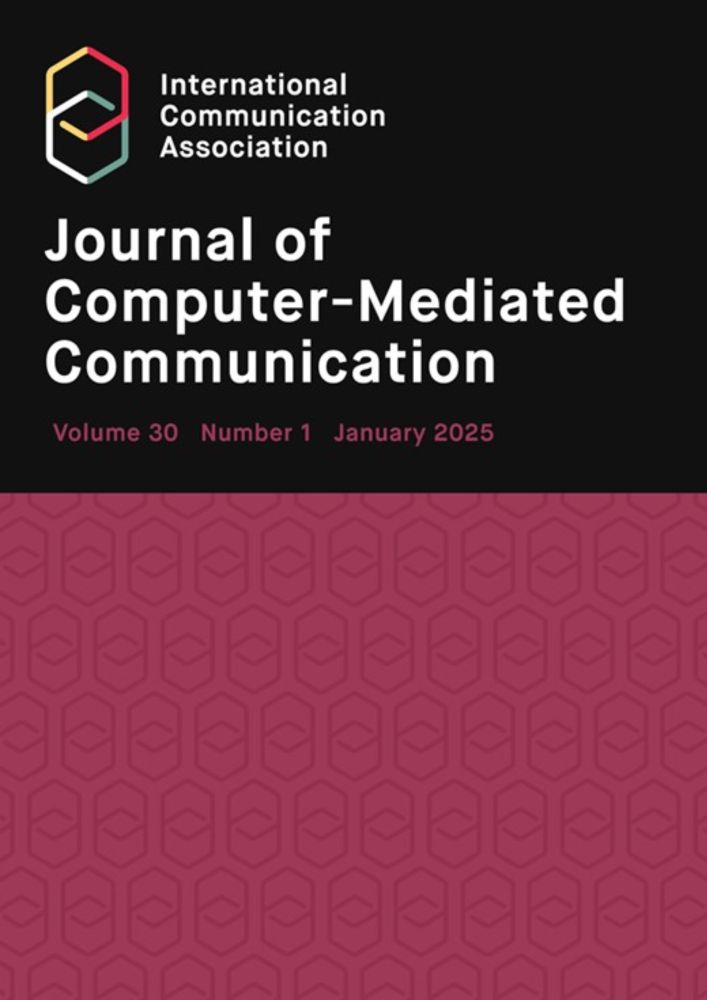
Why do users limit the extent to which their engagement w/news content can be seen by others? @oriten.bsky.social (2025) shows 4 key drivers: protection, pointlessness, personality & particularity. How? Through reducing volume of expression, using private spaces & preferring closed-ended reactions 🧪
11.02.2025 04:42 — 👍 9 🔁 2 💬 3 📌 0
Thanks for sharing, @overbye.bsky.social!
11.02.2025 05:44 — 👍 1 🔁 0 💬 0 📌 0
The article draws on research supported by the Social Sciences and Humanities Research Council of Canada. I thank Bridget Stringer-Holden and Shaurya Kshatri for their invaluable assistance during the research process, as well as the Angus Reid Group for their help in participant recruitment
6/6
29.01.2025 17:36 — 👍 1 🔁 0 💬 0 📌 0
The study advances the understanding of news engagement by suggesting that it involves the management of visibility boundaries and by elucidating barriers to public expression
5/6
29.01.2025 17:36 — 👍 1 🔁 0 💬 1 📌 0
The study also presents three ways to limit news engagement visibility, including lower 𝑒𝑥𝑝𝑟𝑒𝑠𝑠𝑖𝑜𝑛 𝑣𝑜𝑙𝑢𝑚𝑒, more private 𝑒𝑥𝑝𝑟𝑒𝑠𝑠𝑖𝑜𝑛 𝑠𝑝𝑎𝑐𝑒, and more closed-ended 𝑒𝑥𝑝𝑟𝑒𝑠𝑠𝑖𝑜𝑛 𝑡𝑦𝑝𝑒
4/6
29.01.2025 17:36 — 👍 1 🔁 0 💬 1 📌 0
Based on interviews and literature on privacy, avoidance, and engagement, I propose the 𝑓𝑜𝑢𝑟 𝑃'𝑠 𝑓𝑟𝑎𝑚𝑒𝑤𝑜𝑟𝑘 to explain the reasons behind limited news engagement visibility: protection, pointlessness, personality, and particularity. Each is presented in detail
3/6
29.01.2025 17:36 — 👍 1 🔁 0 💬 1 📌 0
The article focuses on what I term 𝑛𝑒𝑤𝑠 𝑒𝑛𝑔𝑎𝑔𝑒𝑚𝑒𝑛𝑡 𝑣𝑖𝑠𝑖𝑏𝑖𝑙𝑖𝑡𝑦—the extent to which a user’s involvement with news content can be seen by others. This visibility is shaped by a user’s tendencies to express themselves or avoid such expressions in relation to news beyond consuming it
2/6
29.01.2025 17:36 — 👍 1 🔁 0 💬 1 📌 0

Under-the-radar engagement: how and why news users limit their public expression
Abstract. Beyond digital news consumption, users may express themselves in relation to the consumed news—for example, through commenting, sharing, or react
How and why do people limit the visibility of their interactions with news? My newly published article in the 𝐽𝑜𝑢𝑟𝑛𝑎𝑙 𝑜𝑓 𝐶𝑜𝑚𝑝𝑢𝑡𝑒𝑟-𝑀𝑒𝑑𝑖𝑎𝑡𝑒𝑑 𝐶𝑜𝑚𝑚𝑢𝑛𝑖𝑐𝑎𝑡𝑖𝑜𝑛 examines these questions, drawing on in-depth interviews with news users in Canada
academic.oup.com/jcmc/article... (open access)
1/6
29.01.2025 17:36 — 👍 2 🔁 0 💬 1 📌 1
Editor of @niemanlab.org / a fun mom in Cambridge, MA
https://illberightback.substack.com/
Ebikes | Mysteries | Baking | Parent gossip | Public schools
internet culture reporter. human garbage bag.
Reporter lady. MSNBC. Signal username: brandyzadrozny.53
Email if you must, from a non-work account: brandy.zadrozny@nbcuni.com
White House Correspondent for @NBCNews. Tips? Email: Yamiche.Alcindor@nbcuni.com.
Senior Executive Editor, VP at NBC News Digital.
Tips: www.nbcnews.com/tips
Politics Managing Editor, NBC News amanda.terkel@nbcuni.com
Assistant managing editor, national security and justice, at NBC News. Previously CNN, Guardian US, New Yorker. My wife says I have to tell you I got my Bluesky invite from her and that it means she's the cool one in the marriage.
Reporter for NBC News covering the LGBTQ+ community.
DMs open; email Jo.Yurcaba@nbcuni.com; Signal @joyurcaba.91
Pronouns: they/them
NBC News senior reporter | Author of THEY CAME FOR THE SCHOOLS | Co-creator of SOUTHLAKE & GRAPEVINE podcasts | Retired t-ball coach
www.mikehixenbaugh.com
Tech reporter at NBC News. Based in San Francisco. Read my latest work here: https://www.nbcnews.com/author/david-ingram-ncpn890161
On Signal: davidingram.77
I cover digital threats for NBC News. Tip me! @kevincollier.01 on signal, kevin.collier@nbcuni.com. NYC, from West Virginia.
deputy tech editor, NBC News — online investigations, extremism, child safety — tech/politics/culture
Signal: beng.38
https://linktr.ee/bengoggin
My newsletter: https://open.substack.com/pub/bgoggin
benjamin.goggin@nbcuni.com bgoggin@protonmail.com
☀️ Host @waytooearly.bsky.social
📕 Author “Electable: Why America Hasn’t Put A Woman In the White House…Yet.”
Read: https://a.co/d/j1ojmjm | Watch: https://www.youtube.com/playlist?list=PLDIVi-vBsOEwfv0LML1BGBlPxZsnoa0xM
NBC News Senior National Political Reporter covering Capitol Hill and elections 🏛️🗳️
Part-time Formula 1 correspondent 🏁🏎️
https://linktr.ee/sahilkapur
@nbcnews.com Senior Justice reporter, ebike guy.
Read my stuff: http://ryanjreilly.com/
Order my book: https://www.publicaffairsbooks.com/titles/ryan-j-reilly/sedition-hunters/9781541701809/
Message me on Signal: @ryanjreilly.62
🚲⚖️🕵️🦅🛎️🇺🇸
Independent journalist covering internet culture, politics, and media @spitfirenews.com. Buy me a coffee: https://ko-fi.com/kattenbarge
NBC News science and climate reporter based in Seattle.
MSNBC Anchor, co-host of the podcasts Southlake & Grapevine, & Author of MADNESS
NBC News Chief Capitol Hill Correspondent
Ex-journalist. Occasional commentator. Collector of hobbies. Mother of 2. Resident of Virginia. Grad of LSU and GMU Law. Geaux Tigers.


